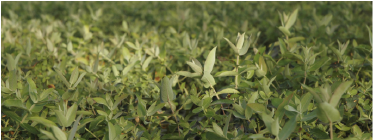Ence Biogas
Leaders in sustainable use of natural resources
Ence Biogas is Ence’s subsidiary for the development of biogas and fertilizer production projects in Iberian Peninsula.
Ence Biogas promotes the circular economy by transforming organic waste into biogas for injection into the grid. The digestate generated after biogas production will be used to transform it into biofertilizers and water for irrigation.
This activity has important synergies with Ence’s pulp and biomass activity.

WHAT IS BIOGAS?
Biogas is a renewable fuel generated in the recycling treatment of non-hazardous organic waste.
Biogas is a gas composed mainly of methane (CH4) and carbon dioxide (CO2), in variable proportions depending on the composition of the organic matter from which it was generated. The main sources of biogas are agricultural waste, livestock, agri-food industry and other organic waste of domestic origin.
Biogas usually has a methane content of 50 – 70%, this hydrocarbon being what gives it the characteristic of fuel. If you want biogas to resemble natural gas, it is necessary to eliminate CO2 and other compounds to increase the methane content of the gas to a percentage greater than 96%. This gas with a high methane content is known as biomethane.
Which are your principal characteristics?
- Chemical composition and energy power very similar to natural gas, so it can be used for the same purposes:
- Injection into the gas network: mixed with natural gas for use in the heating and transportation sectors
- Electric power production
- 100% renewable, coming from waste
- Contributes to the development of the circular economy as a sustainable alternative to waste treatment
- It favors the energy transition, thus contributing to the constitution of a decarbonized energy system to meet the EU emission reduction targets
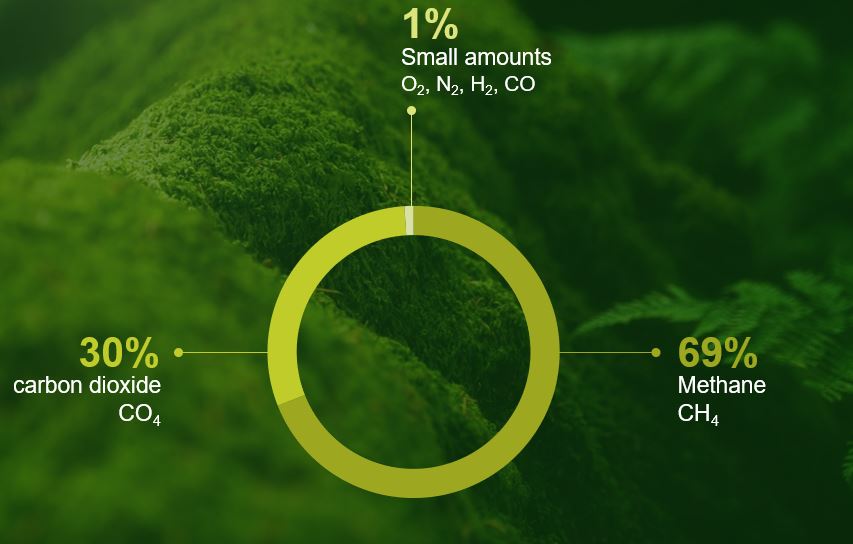
Average values of the production of a typical biogas plant
HOW IS BIOGAS PRODUCED?
Biogas is produced through a process of anaerobic digestion of organic matter.
The process is carried out in a biodigester, which is nothing more than a closed container where said organic matter is deposited.
Anaerobic digestion is a biological process in which organic matter in the absence of oxygen, and through the action of a group of specific organic bacteria, breaks down into:
- Gaseous products or “biogas”, CH4 (50-70%). Thermal/electrical application or upgrading to biomethane
- Digestate, mixture of mineral products (nitrogen, phosphorus, potassium, calcium, etc.) and difficult-to-degrade compounds. Application as fertilizer
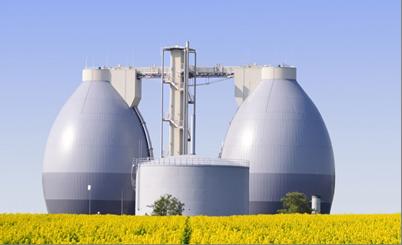
WHAT IS DIGESTATE?
The residue generated in the digestion, the digestate, is a very good raw material for the production of organic fertilizers of renewable origin, thus making it possible to recover mineral nutrients derived from the biogas production process and to recycle very stable carbon in the soil.
In this way, the circle of nutrients and organic matter is closed (circular economy) and Greenhouse Gas (GHG) emissions are reduced, since the majority of GHG emissions in agriculture are due to the manufacture and Field application of synthetic fertilizers.
The use of the digestate obtained in anaerobic digestion is directly related to the economic viability of biogas plants. A semi-liquid material is obtained from the digesters, from which a solid fraction with a total solids content greater than 20% must be separated, which is known as digestate. The nutrients are in this solid phase, except for nitrogen, which remains mostly in the liquid phase. Its presence in the digestate is regulated when there is a problem in its application to the field due to excess nitrogen, generally associated with areas where there is a high concentration of livestock and/or vulnerability to nitrate contamination.
MAIN USES OF BIOGAS
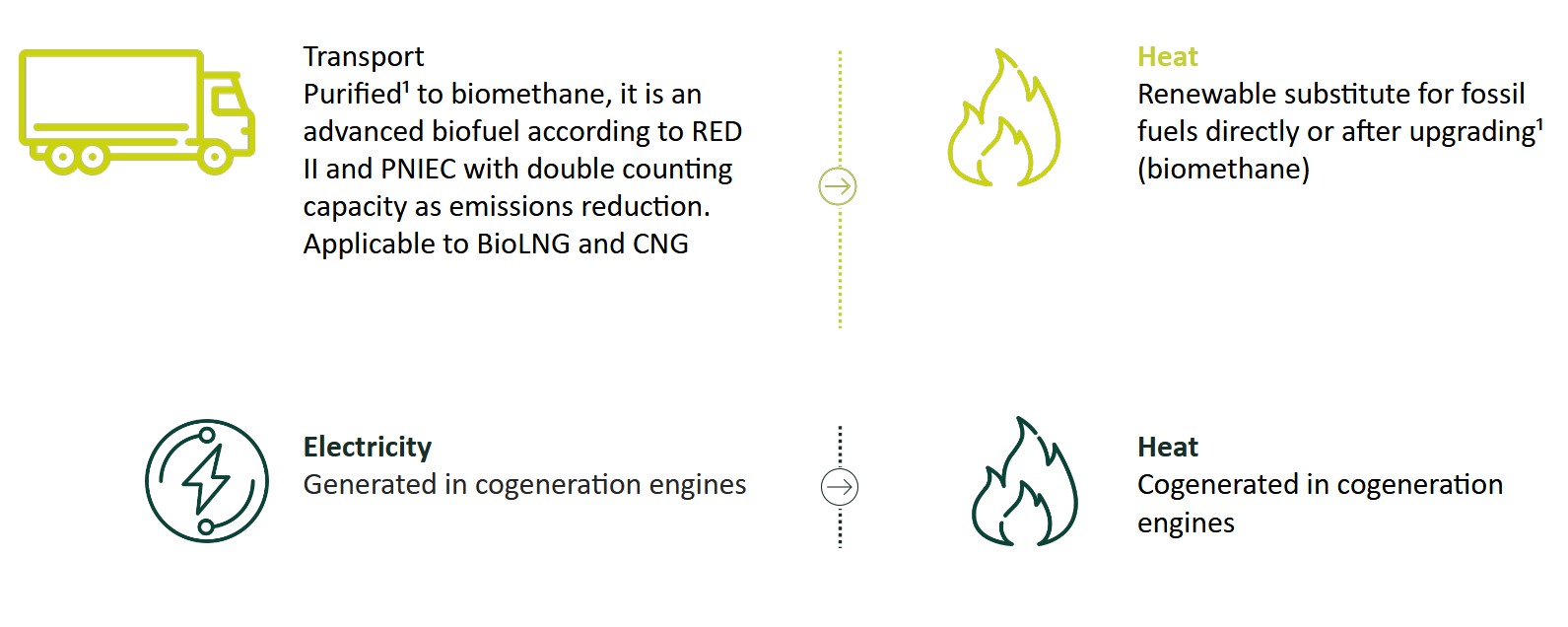
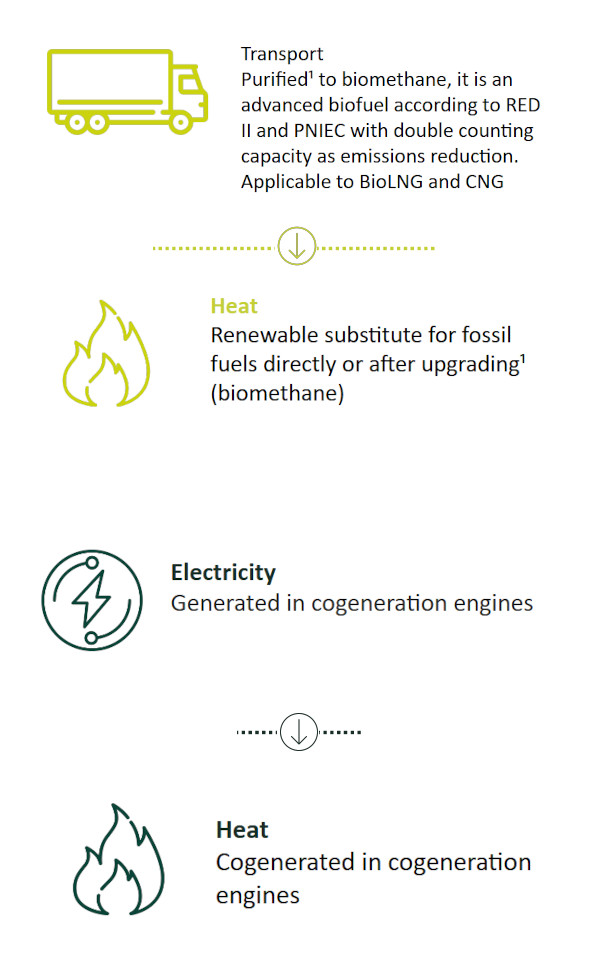
¹ Process for the elimination and cleaning of CO2 contained in the biogas, up to standardized quality of biomethane, a gas with 97% CH4 for its injection into the gas system

